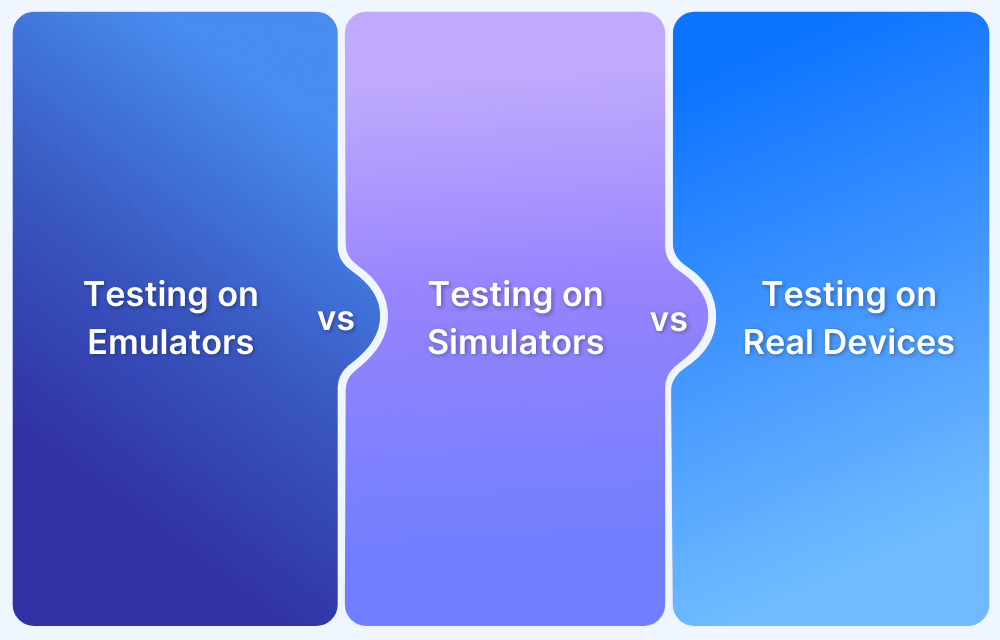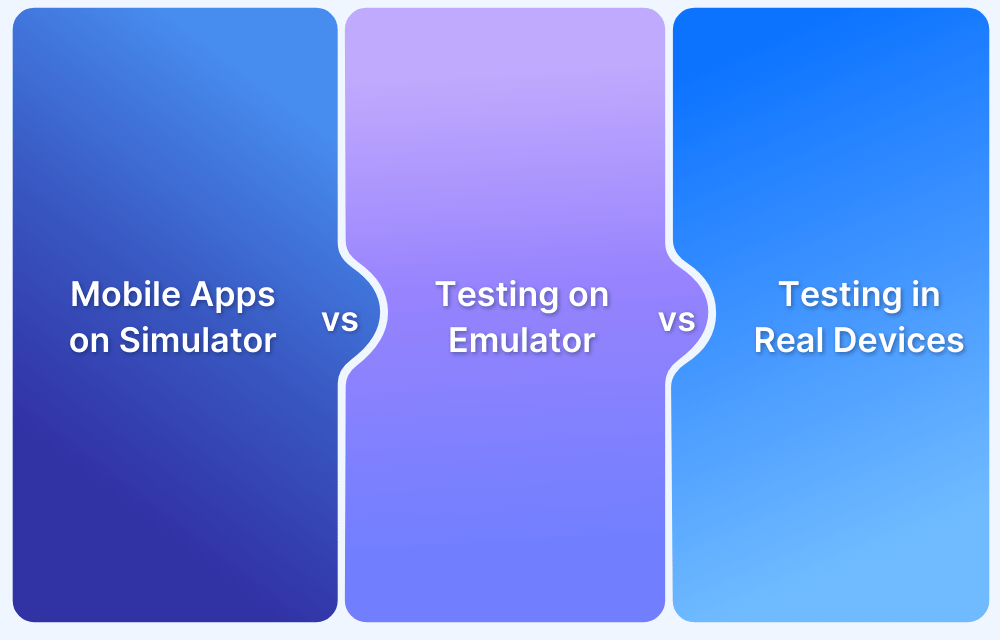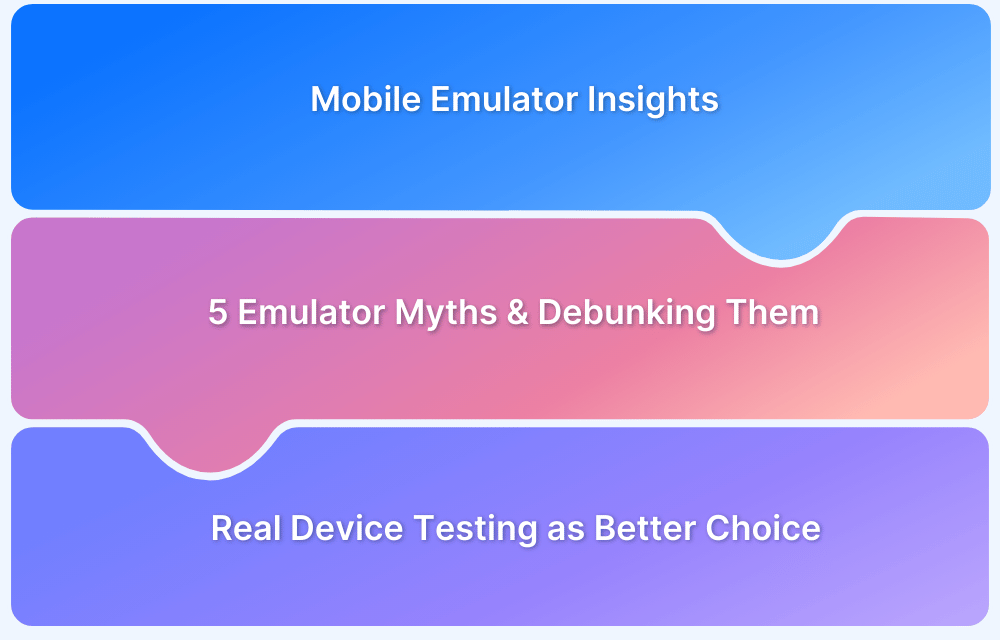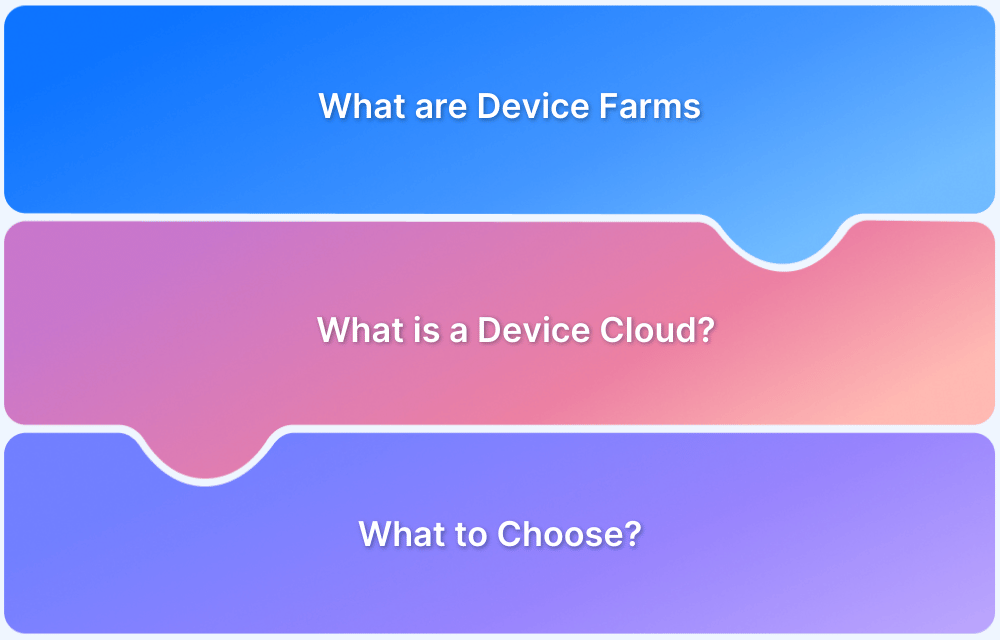Mobile app testing ensures an application works seamlessly across various devices and operating systems. Testing can be performed using emulators, simulators, or real devices, each serving a specific purpose.
Overview
Testing apps or websites for mobile devices is crucial to ensure performance, usability, and compatibility across different devices and network conditions. There are three primary methods for mobile testing: Emulators, Simulators, and Real Devices.
Difference Between Emulators, Simulators, and Real Devices
Performance Testing
- Emulators & Simulators: Cannot accurately measure CPU, battery consumption, or memory usage.
- Real Devices: Provide precise performance metrics under real-world conditions.
Hardware-Specific Testing
- Emulators: Can mimic some hardware features but not all.
- Simulators: Do not support hardware interactions.
- Real Devices: Essential for testing hardware-dependent functionalities like sensors or cameras.
Network & Connectivity Testing
- Emulators & Simulators: Offer limited or simulated network conditions.
- Real Devices: Allow testing on actual Wi-Fi, mobile networks, and real-world latency issues.
App Behavior on Different OS Versions
- Emulators: Useful for testing across multiple OS versions quickly.
- Simulators: Limited to the software environment without actual OS-level behavior.
- Real Devices: Show how apps behave with actual OS updates, customizations, and manufacturer tweaks.
This article explores the different mobile testing device solutions, including real devices, emulators, and simulators, their differences, and when to use each for effective app and website testing.
Types of Mobile Testing Device Solutions
As the technology has evolved with time, testing also saw its share of advancements in various mobile testing device solutions that emerged. These mobile testing solutions were built in order to support cross browser testing of websites and mobile app testing on different mobile phones by analyzing the application’s behavior, function and UI aspects.
The prime reason for this kind of testing is to ensure consistent behavior of the website and app on different mobile devices. Since these devices differ by hardware configuration, operating system, and screen resolution, what might work in a certain way on one of the devices could vary for the other.
There are mainly two types of devices on which mobile testing is conducted:
- Real Devices
- Virtual Devices
What is a Real Device Testing?
Real device testing involves testing mobile applications and websites on physical devices to evaluate their performance, usability, and compatibility under real-world conditions. Unlike emulators and simulators, real devices provide accurate results by considering factors like hardware limitations, battery consumption, network fluctuations, and sensor behavior.
Start Testing on Real Device Cloud
What is a Virtual Testing Device?
A Virtual Testing Device is a software program on the computer, unlike a real device, that provides simulation for most of the important features of an actual smartphone device. It mimics the nature of the smartphone, which helps the testers to run the software application on it to get an idea about how it would run on the designated real device.
Although virtual testing devices happen to mimic the devices and are cost-efficient, it cannot replace real devices due to accuracy and reliability factors.
There are two types of virtual testing devices:
- Emulators
- Simulators
What are Emulators?
An Emulator is a software that mimics the hardware and software of the target device on your computer. They do this by translating the ISA (Instruction Set Architecture) of the target device to the one used by the computer you are using to conduct testing using binary translation.
ISA is the set of instructions that are written in Machine Language by each of the processor families, which they use to build their own device configuration depicting the functionality and behavior of the device.
By translating the ISA of the target mobile device into your computer, you can mimic the way your target device works, forming a virtual environment for testing.
However, these near-native capabilities of the target mobile device, that enable you to adjust the physical sensors, geolocation, etc., come at the cost of latency.
Android emulator, Galaxy emulator, and iPhone emulator (which is a misnomer for iOS Simulator actually) are some of the widely used emulators for software testing.
What are Simulators?
A Simulator is a software that helps your computer run certain programs built for a different Operating System. They are mostly meant for iPhone and iPad devices, unlike Android devices that can be emulated easily.
The iOS simulators mimic iOS and run the required application inside it, by sitting on top of the computer’s Operating System. But to run the iOS simulator, one needs to work on the macOS only, as it needs Apple’s native Cocoa API. This Cocoa API is essential for the GUI, runtime, and many other operations.
This poses an issue as developers have to either work on the MacBook or virtualize macOS on their existing systems.
Simulators, unlike emulators, do not mimic hardware. Thus one cannot investigate certain functionalities like battery usage, cellular interrupts, etc. while using simulators for testing.
Emulators vs Simulators: Know the difference
While these virtual testing devices are sometimes interchangeably used in communication, in reality, emulators and simulators differ from each other in many ways.
| Criteria | Emulators | Simulators |
|---|---|---|
| Target Area | Mobile device hardware, software, and Operating System | Internal behavior of the mobile device |
| Provided by | Emulators are provided by device manufacturers | Simulators are provided by device manufacturers and other companies |
| Internal Structure | Written in Machine-level assembly language | Written in High-level language |
| Suitable for Debugging | Emulators are reliable and more suitable for debugging | Simulators, on the other hand, are less reliable and not so suitable for debugging |
| Performance | Binary translation makes them slower due to latency | Simulators are faster as there is no Binary Translation |
| Example | Android SDK | iOS Simulator |
Real Testing Device vs Virtual Testing Device
Real testing devices and virtual testing devices differ in their capabilities.
| Criteria | Real Testing Device | Virtual Testing Device |
|---|---|---|
| Cost | Buying real devices at scale is cost prohibitive | The minimal cost incurred as oftentimes one can install them for free |
| Reliability | Real devices exhibit accurate results and allow for testing in the same condition as a user | Virtual testing devices only mimic the device and can’t replicate real user conditions like hardware and software configurations |
| Processing Speed | Software testing on real devices is much faster | Software testing on virtual devices is slower due to Binary translation |
| Suitable for Debugging | Debugging with real testing devices could be tricky, especially while capturing defects | Virtual devices make step-by-step debugging easy with the features, where you can capture the defects |
| Cross-Platform Testing | Cross-Platform Testing can normally be conducted using real devices | Cross-Platform Testing can be seamlessly conducted using virtual devices |
Real Device, Emulators, and Simulators: When to test on what
With the features that each of these devices offers, when used diligently they can deliver optimized results making cross-browser compatibility testing a lot easier. The best practices primarily include testing on the right devices for better outcomes.
Start testing on Real Device Cloud
Since the virtual devices offer a better debugging facility, it is best suited to use during the initial stages of code development. Virtual devices could make the cycle faster and more efficient with the frequent iterations required in the initial stages.
On the other hand, due to the accuracy factor, Sanity Testing and User Acceptance Testing can be better done with real devices. Parts of Regression testing could still be done using virtual devices after a point, it might result in compromised results.
Evolution of Testing Devices: From Real to Virtual Testing Devices
Although the results generated by testing on real devices are highly accurate, the cost of testing is on the higher side, as the company has to buy multiple devices and has to update them from time to time as new devices hit the market.
This expense of testing on real devices was a big challenge that companies have overcome by introducing virtual testing devices such as Simulators and Emulators. Thus, virtual testing devices came into regular use while conducting cross browser compatibility testing for the software.
While virtual devices help in early-stage testing, they cannot fully replicate real-world conditions such as network fluctuations, battery performance, and hardware-specific behavior.
Real devices remain the best choice for comprehensive and reliable testing. They ensure apps perform flawlessly across diverse environments and deliver a seamless user experience.
Using a Real Device Cloud, like BrowserStack, enables testers to access a vast range of real devices remotely, eliminating the need for maintaining an in-house device lab while ensuring high-quality mobile experiences.
Difference Between Testing on Emulators vs Simulators vs Real Devices
Here is a comparison table for Testing on Emulators vs Simulators vs Real Devices:
| Feature | Emulators | Simulators | Real Devices |
|---|---|---|---|
| Definition | Software that mimics the hardware and software of a real device | Software that mimics only the software environment of a real device | Physical device used for actual testing |
| Performance | Slower due to hardware emulation | Faster since it only mimics the OS | Real-world performance testing |
| Hardware Simulation | Yes | No | Yes |
| OS Simulation | Yes | Yes | Native OS |
| Network Testing | Limited | Limited | Real-world network conditions |
| Accuracy | High for functional testing | Moderate, may not match actual device behavior | Most accurate representation |
| Suitability | Early-stage development & debugging | UI testing and behavior analysis | Performance, compatibility, and real-world scenario testing |
| Access to Device Features | Limited | Limited | Full access |
| Best Used For | Debugging and functional testing | UI and basic behavioral testing | Performance, battery, and real-world condition testing |
Take a step ahead with Real Device Cloud
Real and virtual devices have pros and cons, making them suitable for one phase of testing and not so much for others. However, adopting a Real Device Cloud for testing can provide the best of both worlds.
Get your testing done right with just a single real device cloud that offers you
- Native real device experience, accuracy, and reliability
- Cost savings
- Easy debugging like virtual devices
- Web automation testing and app automation mobile testing for rapid testing at scale
- Hassle-free live interactive cross-browser testing and interactive app testing
Real device cloud is thus the ideal solution, both for testers to find bugs and for developers to fix bugs with ease while keeping costs low.
Conclusion
While emulators and simulators help in early testing, only real devices provide accurate performance, compatibility, and user experience validation. Leveraging a Real Device Cloud, like BrowserStack, ensures reliable testing without the high costs of maintaining physical devices, making it the best approach for comprehensive mobile testing.





